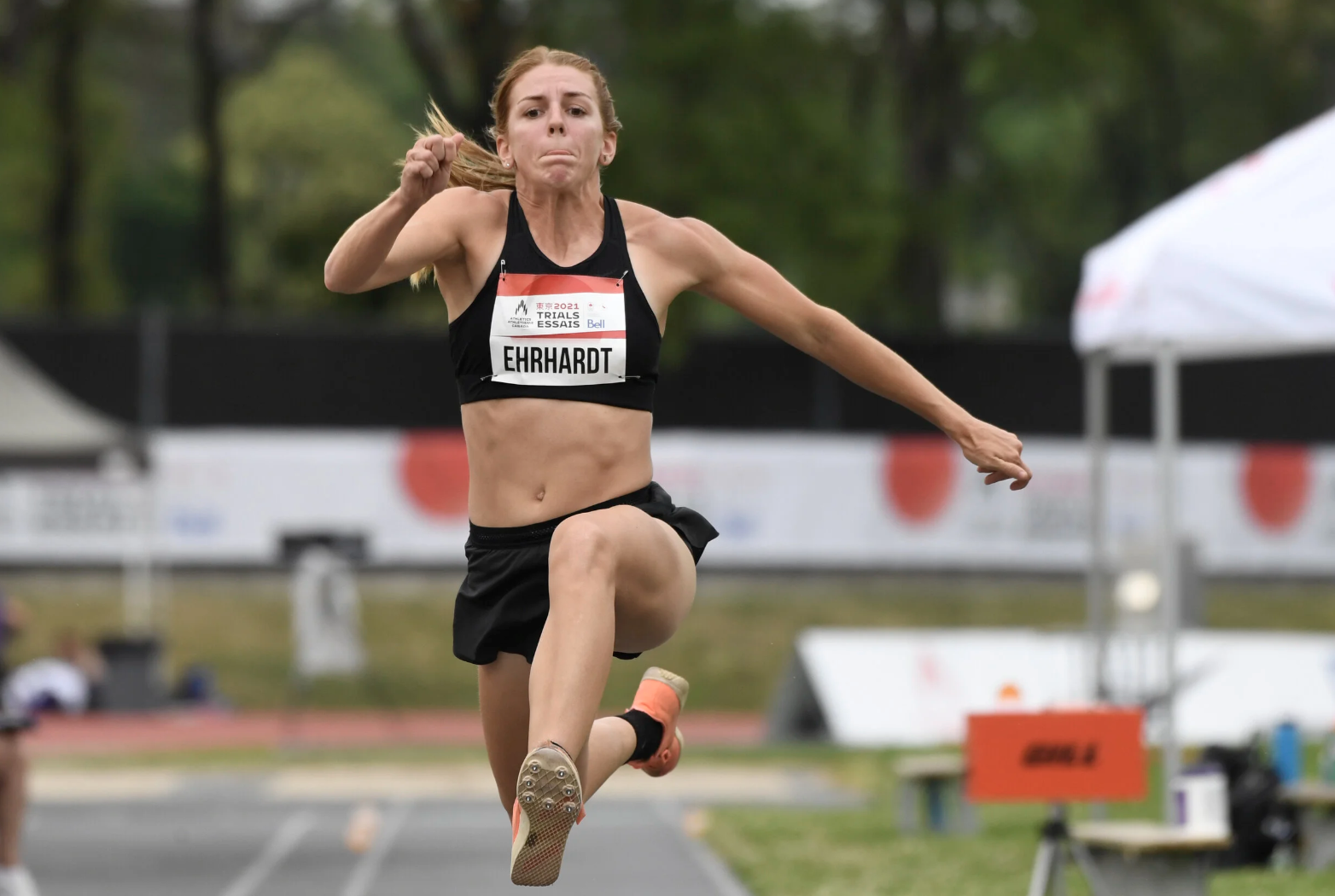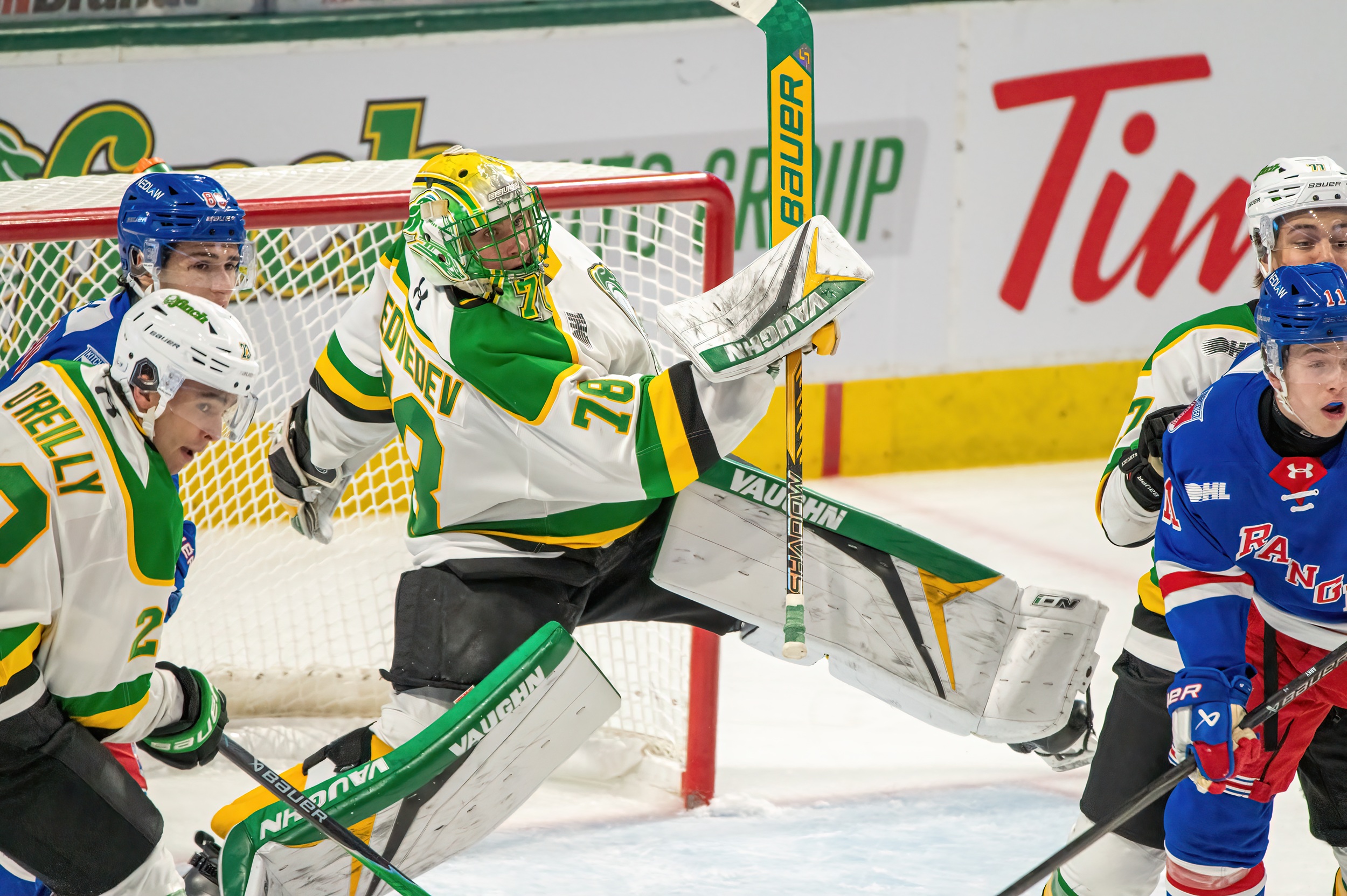|
Getting your Trinity Audio player ready...
|
Caroline Ehrhardt fell short in her bid for Tokyo. At 29, the nine-time Canadian champ is disappointed — but she’s not done yet. There remains an elusive goal …
Admittedly, Caroline Ehrhardt faces plenty of unknowns, from the severity of a plantar plate tear in her takeoff foot to what job she’ll land after months away from the traditional workforce.
But a return to high-level competition? There’s no question there.
She will be back, competing nationally and internationally in the sport that’s consumed her for nearly two decades.
Caroline Ehrhardt is not done yet.
* * *
You wouldn’t blame her if she hung up the spikes.
The 29-year-old has already enjoyed a decorated postsecondary career at Western University, medaled in numerous international events, and stands as a nine-time national champion in the women’s triple jump, including a win this year at a scaled-back, fans-free Athletics Canada Olympic Trials event in June in Montreal.
This summer, she was one last hop, bound and jump into the sandpit from qualifying for the Olympic Games – something no Canadian woman has ever done.
But that dream never got off the ground.
Though she carried a confident attitude into the event, the reality was that Ehrhardt was nursing a significant foot injury she’d suffered the week prior. She was in pain just walking. It took one jump to find out that the dream – at least this year – was over.
“Halfway down the runway, I took a step and it felt like something shifting in there. That’s when I knew it was the end of the road for me,” said Ehrhardt. “It was very painful, and it became clear pretty quickly that I wasn’t going to be able to jump through the injury.”
Ehrhardt took one more jump. In fact, she outjumped the only other competitor in the event and won. (At a non-COVID-19 championships, she’d face a field of at least eight).
Her winning jump, however, was only 12.98 metres – not in the same postal code as her 13.83-metre personal best.
“I wasn’t even able to go out there and give it my best effort,” Ehrhardt said. “I wanted my last kind of Hail Mary chance at getting on the team, but I just couldn’t do that with where my body was at.”
But she’s not done yet.
* * *
Caroline Ehrhardt just jumped her way to the women’s triple jump title with a best jump of 12.98 metres.
Caroline Ehrhardt s’empare du titre féminin du triple saut avec une performance de 12,98 mètres.#ACTrials21 #EssaisAC21 pic.twitter.com/T4RAJmYmLq
— Athletics Canada (@AthleticsCanada) June 25, 2021
This was supposed to be the year.
For the first time in her career, Ehrhardt – and her husband, Taylor, a decathlete – made the decision to leave their jobs and “go all-in.” It was an Olympic year, after all, and they’d worked hard for it, saving up enough money to be full-time athletes for a year.
They took pride in making it on their own. Like many amateur athletes (even national champions), the couple isn’t funded by a national or provincial sport organization.
Unfortunately, expenses still added up, like travel to compete.
“Meets weren’t happening fast enough in Canada (due to COVID). We knew that to give ourselves a fighting chance, we had to get out of here, unfortunately,” Ehrhardt said.
They needed help to do that. For the last four years, Taylor has worked at Canadian Tire in Hyde Park. So, when the store funded a significant part of that California trip, the family was relieved and grateful.
“We literally wouldn’t have been able to do it without them,” Ehrhardt said. “When (Taylor) left in the fall, the store owner made it very clear, ‘If you guys ever need anything, we’re always going to be here to support you.’ We could not have been more grateful.”
The couple left for California the last day of February and returned in the middle of May. While there, Ehrhardt jumped a season-best 13.74 metres at a meet.
Yes, this was supposed to be the year.
But the obstacles kept coming.
In January, Athletics Canada announced that, due to COVID-19, they’d only be hosting events where at least one athlete had a realistic chance of qualifying for Tokyo.
Ehrhardt was worried right away. What was ‘realistic’?
At the time, she was ranked 42nd in the world, 10 spots away from qualifying for the Games as a top 32 jumper. But higher-ranked meets in North America (to gain more points) were hard to come by. So, even though she was winning events with jumps in the high 13’s, she was unable to move up in the rankings over the next four months.
In May, Athletics Canada announced the Trials schedule. Women’s triple jump wasn’t on the list. It took the help of some higher ups to allow the reigning national champion to get to jump in her event in Montreal.
“I was fortunate to have people go to bat for me and fight for my cause so I could have that opportunity,” Ehrhardt said. “That was the biggest difference this year. The fact even if you were the top in your event in the country, it wasn’t a guarantee that your event would be hosted.”
Ultimately, she got that opportunity. It didn’t go as planned. With the world’s best female triple jumpers posting impressive results throughout the season, it became apparent by the time Canadian Trials rolled around that Ehrhardt would have to jump the automatic Olympic standard – 14.32 metres – to qualify for the Games, something no Canadian has ever done.
Ehrhardt’s injury took away any possibility of a Hail Mary jump to Tokyo. It was a disappointing end to her season. But she knows disappointment, and she’s bounced back more times than she can count.
She’s not done yet.
* * *
It’s a niche event. The long jump is fairly straightforward, even for the casual observer. But the triple jump …
An athlete runs down the track, performs a ‘hop,’ followed by a ‘bound’ and then a ‘jump.’ Per IAAF rules:
The hop shall be made so that an athlete lands first on the same foot as that from which he has taken off; in the step he shall land on the other foot, from which, subsequently, the jump is performed.
Got that?
Caroline Ehrhardt got it when she was 11 years old – and she’s been doing it “obsessively” ever since.
More of a middle-distance runner in elementary school, she also competed in the jumping events. At school board meets in Grade 7 and 8, Ehrhardt chose the 800m, 1500m and the triple jump.
“Even when I was in Grade 9 at OFSSA, the events I did were triple jump and the 800, which is a really weird combination,” said Ehrhardt. “I actually had to leave the jumping pit to go run the 800, and then run back and try to get my last few jumps in.”
As she got older, it became clear it wouldn’t be possible to excel in both. With the school board records she was breaking in the triple jump, she made the decision that the unique jumping event would be her specialty.
Ehrhardt broke the Canadian high school record in her teens. At 16, she medaled (bronze) at her first Canadian Olympic Trials in 2008. Her first international competition came in 2009 at the World Youth Championship, and then she competed – and met her future husband – at the 2010 World Junior Championship in Moncton.
Taylor, a London native, and Ehrhardt, who grew up in northern Ontario, both attended Western. There, Ehrhardt continued her ascent as a dominant triple jumper, medalling at OUA and CIS (now U Sports) championships.
In 2015, she broke a 22-year-old Canadian university women’s triple jump record. She was named Western’s graduating athlete of the year.
Her coaches today with the London-Western Track and Field Club are the same she had during her university days – Vickie Croley and Frank Erle.
“We’ve been through a lot together,” Ehrhardt said. “They coach me for free; they take time away from their families and they’re still so encouraging. For me to just keep trying, just keep showing up, we’re going to get this thing figured out. That really means the world to me.”
Taylor endured his own disappointment at the Canadian Trials in June, dropping from first to second place in the final decathlon event (the 1500m). Like Caroline, Taylor is close to making an Olympic team (his personal best of 7,900 points is short of the 8,300-point qualifying standard).
“Part of why we’re so good for each other, and why it’s so helpful to have someone else in this sport, is that one of us can always be the strong one for the other. So, most often, when I’m doing really well, he’s struggling, and vice versa. It’s very rare that we’re both taking blows at the same time.
“It’s been hard (after Trials) because we’re both very discouraged right now. But I know there’s a lot more in us, and that we can do it, and that not right now doesn’t necessarily mean never. And the only way to really know for sure is to just keep trying.”
No, she’s not done yet.

* * *
Caroline Ehrhardt is resilient. She’ll bounce back from all the disappointment. Of Trials. Of injury. She’s been bouncing back for a long time, and she’s gained a lot of perspective.
She need only think back to 2017.
Having made the World Francophone (Jeux de la Francophonie) team, she was set to compete at the Games in the Ivory Coast. Two weeks before the meet, her father unexpectedly passed away.
Klaus was Ehrhardt’s only parent, as her mom had passed away when she was younger. When she was in Grade 8, her dad built her a backyard jumping pit. He was her biggest fan.
“That was obviously, hopefully, one of the biggest blows I’ll face in my life,” Ehrhardt said. “But I made the decision to get on the plane and go to the Games because I knew that it was something my dad would want me to do.”
While grieving and running on adrenaline, Ehrhardt jumped further at that meet than she ever had before – by 30 centimetres. Every jump she made, six consecutively, was farther than the last. She won the event. Her 13.83-metre gold medal performance still stands as her personal best.
That moment also still stands as the personal highlight of Ehrhardt’s career.
“Not because I won. Not because that was my personal best,” she said, “But because that is the moment I go back to when I’m going through times like I am right now. I just stop and think to myself … in the list of all the crap I’ve had to endure in my life, this, right now (not making the Olympic team), this doesn’t even make top five. I can get through this no problem.”
She will, and she’ll get back to training – because it’s what she does.
“I love the grind. I love working as hard as I can. This is something I’ve been doing every day for the past nearly two decades, and I still show up to practice every single day genuinely excited to do whatever I’m doing that day,” Ehrhardt said. “That’s how I know that it’s definitely still enjoyable for me, even through the hardships.”
And it’s why she’s not done yet.
***
What’s the goal? The Canadian record.
It’s 13.99 metres. She’s been close. She repeated her personal best at a meet in California in 2018, but the record held by Tabia Charles (set in 2010) remains elusive.
“It feels like every time I get really close, something immediately happens,” Ehrhardt said. “I’m so close I can taste it, and then all of a sudden I’m nowhere close anymore. I feel like it’s eluded me for so long, and I’d really like to achieve that.”
That’s been Ehrhardt’s primary goal for awhile now, in part because other goals, including making World Championship and Olympic teams, often feel out of her control – whether it’s because of a flawed scoring system, or the fact that the Olympic standard is more than 30 centimetres further than any female Canadian triple jumper has achieved.
“I’m really gunning for this Canadian record, because it’s very attainable to me, and whatever other success comes hand-in-hand with that, that’s great. It’s almost going to be like what happened with the four-minute mile – one person does it and all of a sudden you realize it’s possible and it just goes from there. Once I get over this 14-metre barrier, the sky is the limit because I’m just going to be able to build off that, once I know I can do it.”
Her coaches think she can do it.
On bad days, Ehrhardt says, she’ll have thoughts that maybe it’s just not in the cards. Maybe it just won’t happen, she says. She’s 29 years old, and she’s been jumping the same distance for several years.
“They tell me all the time, ‘You’re going to find success no matter what avenue of life you choose to pursue, but we’re not done here yet. There’s still so much more there.’”
Ehrhardt is going to find out just how much more. First, though, she’s going to take the summer to heal before she puts any firm plans in place. She’s looking for work – preferably something, in the short-term at least, that allows her to be off her feet, as she can’t do a lot of weight bearing with her foot injury.
In the past, she’s worked as an administrative assistant at a chiropractor clinic, done speaking engagements at schools and businesses, even worked at a corndog stand at the Western Fair. It’s all in the name of funding her real purpose.
“I don’t care what I’m doing, I just want to be able to keep doing (triple jump),” Ehrhardt said. “I’ve always kind of had that whatever-it-takes mentality, and I’ve certainly paid my dues to be able to do the full-time athlete thing this year. I’m hoping it’s something I can do again next year.”
You see, she’s not done yet.
***
Ehrhardt’s Twitter bio says all you need to know about her:
Canada has never had a female triple jumper qualify for the Olympics … yet.
Indeed, the Londoner had every intention of making the Olympic team and heading to Tokyo this month. Or, falling short of that, heading to Europe to compete in some meets and continue to build on all the work she put in earlier this season.
“But, you know, such is life,” Ehrhardt said. “You can’t always make plans and expect everything to go according to that plan. That’s just life sometimes. I’m just going to take these next two months and figure out what I want to do differently next year so that we have a different outcome.
“The best-case scenario in my head right now is to work as much as I can between now and November or December, and then once it’s the new year I can hopefully just focus on training and competing.”
But will she commit to another Olympic cycle?
“I can’t say for sure, but the fact that it’s only three years away does make it a little bit more tempting. And (triple jump) is actually an event where it’s more common to see women in their mid-30s hitting their prime, just because it’s such a technical event. It takes years and years to really master it.”
This year’s Olympic field includes jumpers ranging from 19 to 38, with 11 athletes in their 30s.
“I’ve been doing this for a very long time, and I still feel like I’ve seen steady improvement over the years. I know that I still have a lot of good years ahead of me, should I want to keep doing this.”
So, she’s going to keep her Twitter bio as is for now?
“I think I am,” she said. “I think I am.”
Alas, Caroline Ehrhardt isn’t done yet.





